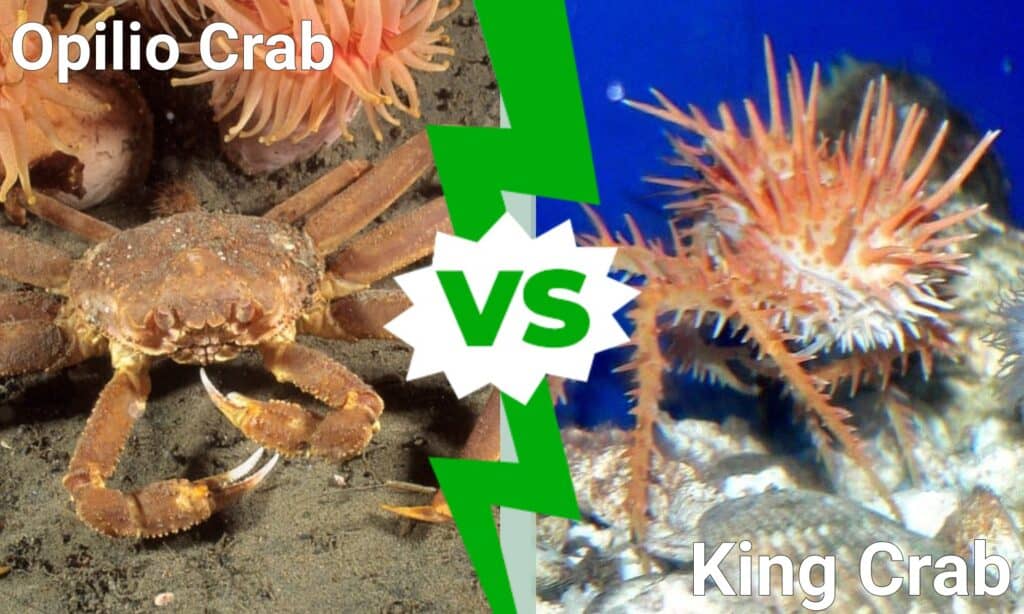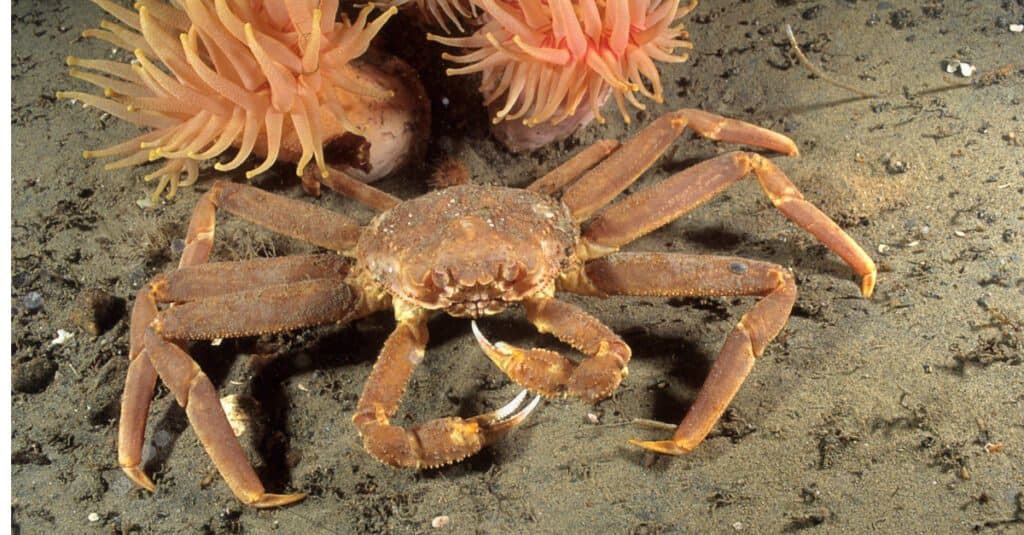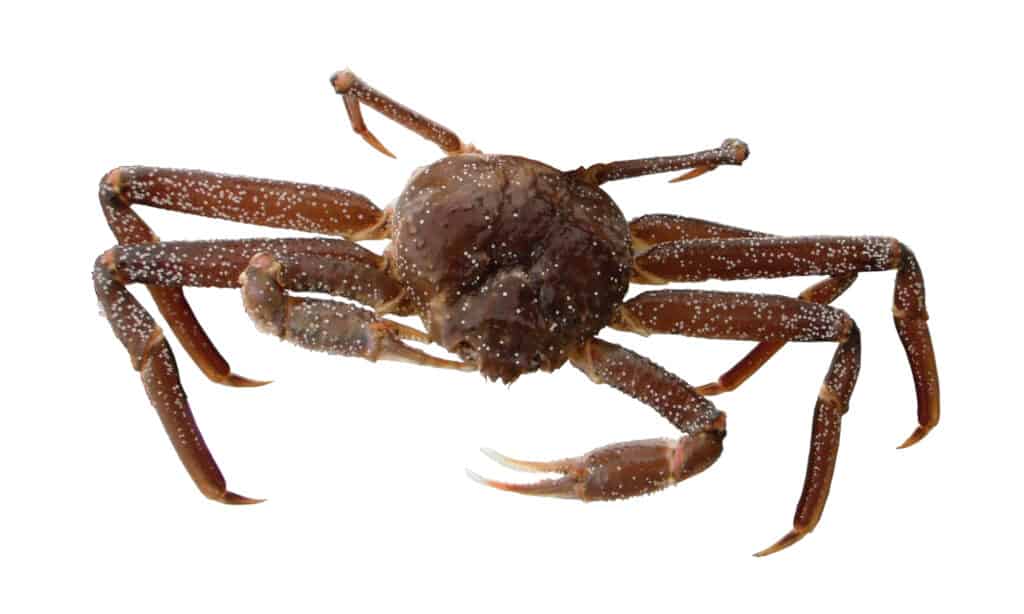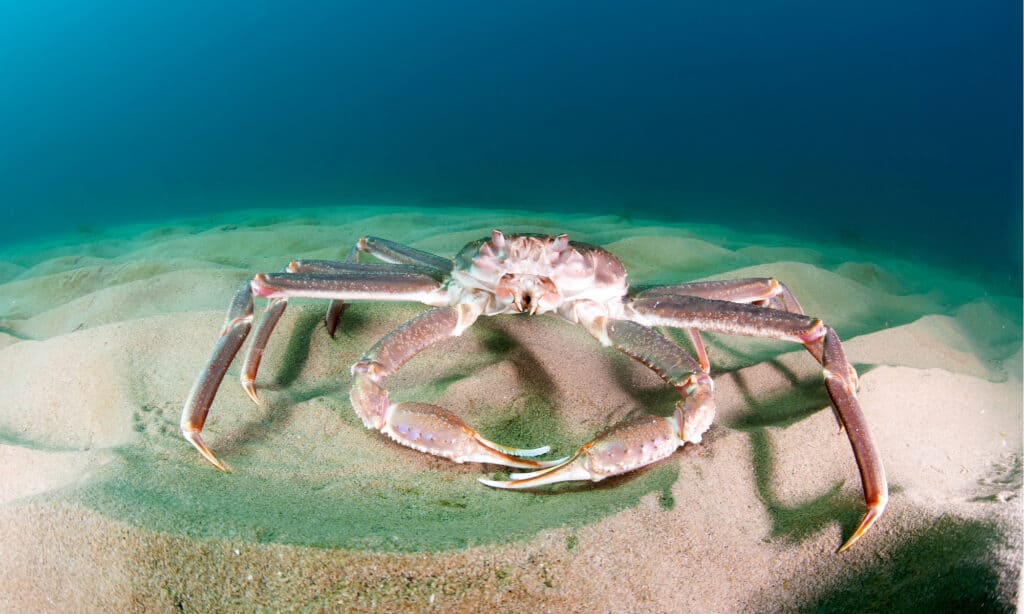The world of crabs is big and complicated, no matter why you want to know more about them. For example, the broad snow crab genus name is Chionoecetes, and it has diverse types of species. The Bairdi and the Opilio, also known as queen or snow crabs, are the two main species that people can buy. King crabs come in three species: Alaskan red, blue, or brown crabs. This article will focus on the distinctions between the opilio crab and king crab in terms of their genus while touching on sustainability and cost.
Opilio Crab vs King Crab: A Comparison

| Opilio Crab | King Crab | |
|---|---|---|
| Size | 3.7 – 6.5 inches wide; 1 – 3 lbs. | 5 – 6 feet wide; 6 – 20 lbs. |
| Looks | Iridescent, Brown to Light Red | Brownish to Bluish Red |
| Location | Northern Hemisphere | Pacific and Arctic Oceans |
| Eating Habits | Crustaceans, Worms, Mollusks | Algae, Worms, Mussels, Small Fish |
| Consumption | $20 – $25 a pound | $60 – $70 a pound |
| Life Expectancy | 14 to 16 years | Up to 30 years |
Key Differences Between Opilio Crab vs King Crab

Opilio crabs are a convenient food source because of their huge legs.
©RLS Photo/Shutterstock.com
The key differences between opilio crabs and king crabs are size, health factors, appearance, and habitat.
King crabs are decapod crustaceans that prefer cold seas. They come in red, blue, and brown varieties. King crabs have thicker, shorter legs than queen crabs, making them richer and more appealing as a food source. As a result of their enormous size and delicious meat, many crab species, including the red king crab, are regularly harvested and marketed for human consumption.
They are a variety of snow crabs found in the Bering Sea. They are often called “Queen crabs” because of their size. Because of their huge legs, opilio crabs, which are big snow crabs, are a convenient food source.
So, what else is different between these two types of crabs? Let’s explore their appearance, habits, habitats, and longevity!
Opilio Crab vs King Crab: Size
The average weight of an opilio crab is one to three pounds. Male crabs are typically much larger than their female counterparts. Males can grow to a carapace width of 6.5 inches, while females can grow to a width of 3.7 inches.
A king crab can spread out to a width of 5 to 6 feet. While the average king crab weighs between 6 and 10 pounds, some reach as high as 20 pounds. Even though many of the 20-pound king crabs were caught in the early 1980s, plenty of them are still around today.
Opilio Crab vs King Crab: Appearance

Snow crab shells are brown or red, and their undersides are shaded with yellow or white.
©Nick Kashenko/Shutterstock.com
There are different shades of brown and red on the top of opilio crabs and white on the bottom. The sides of opilio crabs’ feet are also white. They appear almost iridescent. They have the same length and width of shells covering their entire bodies. Their pincers are frequently smaller, shorter, or the same length as their walking legs, and their first three walking legs are compressed.
This is the largest of the commercially harvested crabs, the red king. They might be brownish or bluish-red in hue and have sharp spines all over them. Three sets of walking legs and one set of claws make up their limb count.
Opilio Crab vs King Crab: Geographic Location
King crabs can be found in the frigid waters of the Pacific and Arctic and off the coasts of Japan, Alaska, Russia, British Columbia, and Canada. The Atlantic Ocean’s northern waters, near Russia, now include king crabs, thanks to deliberate introductions. To reproduce, king crabs travel to shallow waters each year.
The northern hemisphere is home to the subarctic crab opilio. From the Sea of Japan (East Sea) to the Bering Sea, they thrive near Alaska and British Columbia. They also run the length of the Canadian Atlantic coastline, from west Greenland to Nova Scotia.
Opilio Crab vs King Crab: Eating Habits
Oceanic opilio crabs are scavengers and feed on anything from crustaceans to bivalves to annelid worms and mollusk. King crabs eat and crush anything they can get their claws on. Algae, small worms, small clams, and other small invertebrates are common diets for smaller king crabs. Smaller crabs, small fish, sea stars, and barnacles are a few things that larger king crabs eat.
Opilio Crab vs King Crab: Human Consumption
The price of opilio crabs is from $20 to $25 per pound, whereas the price of king crabs is $60 to $70 per pound. Various dishes can be created with snow crab or opilio crab meat, including chowders, omelets, crepes, casseroles, and quiche. It is common to offer split legs as an appetizer or grilled and served hot with drawn butter. Legs and clusters can be steamed whole.
Crab fishing in Alaska is one of the most hazardous occupations in the country. It’s also highly eco-sustainable. Adult male king crab populations in Alaska are limited to a small fraction of the total permissible catch because of tight catch rules and stock rebuilding strategies implemented by the state.
Opilio Crab vs King Crab: Life Expectancy
The average lifespan of an opillo crab is 14 to 16 years. On the other hand, Red king crab males can live for up to 30 years.
Wrapping Up Opilio Crab vs King Crab

Crabs’ habitat influences their flavor.
©Kondratuk Aleksei/Shutterstock.com
Reading about the diverse types of crabs is intriguing, but it’s also interesting to see that crabs’ habitats and eating habits can have a considerable impact on the appearance and flavor of the crabs themselves. If you’re a crab enthusiast, this information may influence your purchasing decisions. It’s also encouraging to discover that incremental improvements in the majority of crab fishing operations are helping to maintain the delicate balance between humans and our ocean’s amazing ecosystems!
The photo featured at the top of this post is © RLS Photo/Shutterstock.com
Thank you for reading! Have some feedback for us? Contact the AZ Animals editorial team.






